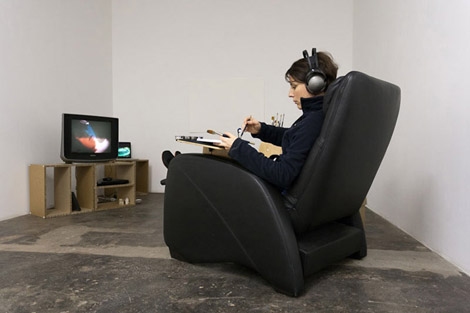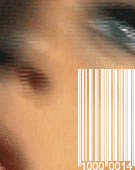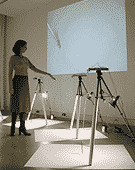Data Capture_LOST & FOUND
drawing performance | BLANK PROJECTS Cape Town 4 August - 3 September 2011
Materials: lazyboy chair, television, adapted TV tray, watercolour & recycled card furniture Dimension: dimensions variable
Full Description
In data capture_LOST I approach the moving image as an object of ethnographic study and contemplation. Through the medium of watercolour (traditionally associated with leisurely pursuit of contemplating the landscape or as ethnographic study) there is an attempt to orientate and begin to navigate the television as a contemporary landscape into which we escape for recreation. In making an active pursuit of an otherwise passive occupation, I hope to open up the space for a meditation on the perpetuation of representations in a television series of the exotic and its shifting nature informed by a pseudo spiritual reference that plays into environmental fears of a shifting planet. For this exhibition all six seasons of the ABC television series LOST, were watched and a watercolour created during each of the one hundred and twenty episodes, each with a forty-minute runtime. The last Season’s episodes were completed as performances in the gallery. In the watercolours I am not interested in trying to create a recognisable picture from watching the television as much as exploring, through the process of the analogue, the threshold of the visible and invisible in perception. If the brain and senses are occupied in recording what I see at every changing moment, what other senses are at work that express through the mark and colour accumulated over an intense meditation on time-based media? So in the LOST watercolour process I attempt to make a mark to capture something only if it is visible on the screen. I start the watercolour as the episode begins and put down my brush as it ends. Through this process the watercolours as colour fields of mark, although chaotic, retain the trace of structure and narrative while taking on movement and changing depth as you view them over time.
In contrast to data capture_LOST, which was performed in the same gallery space, the accompanying drawing action in data capture_FOUND explores the internal journey towards understanding the self through exploring one’s shadow. This time using archival film footage of a mental patient observed performing repetitive and compulsive hand movements, I draw in front of and through the projection blindfolded. I delve inwards, challenging the margins of what defines the seen and unseen and the seemingly futile yet vital necessity of the ongoing psychological journey to image the self as reflected in others.
Work metadata
- Year Created: 2012
- Submitted to ArtBase: Sunday Aug 26th, 2012
- Original Url: http://www.katherinebull.co.za/art/data-capture_lost-found/
-
Work Credits:
- Katherine Bull, primary creator
Take full advantage of the ArtBase by Becoming a Member
Artist Statement
I am currently a practicing artist and part-time lecturer in Visual Art at the Michaelis School of Fine Art, University of Cape Town, South Africa, after ten years of lecturing at the Visual Arts Department at the University of Stellenbosch, South Africa.
In 1998 I was awarded a Master of Fine Art degree from the University of Cape Town with distinction. In my master’s installation and thesis titled Positioning the Cape: A Spatial Engraving of a Shifting Frontier (1996-8) I researched and critically explored colonial printed representations of the Cape history and their relationship to systems of archiving.
As a practicing visual artist trained in traditional printmaking the main thread of my research has been an investigation of the history of the print and its impact on the construction of knowledge systems. The relationship between the archive as a centralized repository of information and the circulation of printed copies away from this locus as a powerful form of visual currency forms another important area of my investigation. In my earlier work (1996-2000), I have mainly manipulated historical examples of printed records and printing processes, in order to critique their relevance as cultural currency within the context of post-colonial theory and contemporary South African Art (http://www.katherinebull.co.za/art/positioning-the-cape-a-spatial-engraving-of-a-shifting-frontier/).
Since 2003 I have become increasingly interested in an investigation of the impact of the digital on printmaking and the archive. The development of digital systems has shifted the form of information from the physical print into coded information. Like a magic genie information appears on command via rgb colour emanating from a LCD computer monitor. In the search for the original, the matrix becomes a search for the Holy Grail of representation. Despite seemingly user-friendly search engines, one has to have blind faith to negotiate the vast network of information available on digital databases and the Internet. Information is simultaneously accessible with no limits to the production and dissemination of multiples. Emphasis shifts now in the dynamics of the archive. The physical distancing from source that happens with printed information through mechanical systems of copying shifts to an interface which enables the constant potential of information to manifest on command from a digital databank.
These interests in how visual representation can function and/or dysfunction to mediate the body’s orientation in time and space have impacted on my creative practice marked by the development of my data project (2004-present). The data project is an ongoing investigation of traditional life drawing and portraiture through the interface of the computer. My digital drawing performances form part of an ongoing series in which I create portraits drawn from life using the digital medium directly without photographic mediation. Through this process I explore the relationship between the real-time projected image that mirrors the drawing process and its output as print. This for me both re-focuses the emphasis onto the act of looking and drawing itself and plays with the different perspectives of the public performance as spectacle and the private moment between the artist and sitter . Through this process I continue in my attempt to bring the physical and virtual into a closer dialogue. My initial interests were to create my own digital heritage archive from scratch by drawing the people around me and starting with the smallest visual interface of the computer, the single pixel as a drawing tool. The data project has evolved from my solo exhibition(http://www.katherinebull.co.za/art/data-new-print-works-by-katherine-bull/), through three international portrait-drawing performances (eg. http://www.katherinebull.co.za/art/data-capture-in-the-field-i/) and another solo exhibition (http://www.katherinebull.co.za/art/data-capture_a-muse/). Through this process my focus in the project shifted from the digital portrait and its output as print to the relationship of the portrait sitting experience as an interactive dialogue between the artist, the sitter and the physical and digital environment. Consequently, my adaptation of my live data capture process to the social and geographical context in which it is being produced has become increasingly important.
In my most recent solo exhibition data capture: LOST & FOUND, I invert my digital drawing process by using a traditional material media (in this case watercolour for LOST as well as ink and grease for FOUND) and made the digital media the subject. The gaze of the artist as mediator of a contemporary cultural landscape of the television series (in the is case LOST Seasons 1-6) is played out as an ethnographic study in which a material archive of time-based media is created. This was placed in a dialogue with the performance of FOUND in which I start to explore the boundary of self-representation. Using the projected film of a psychological study of a female mental patient as a medium I attempt to embody the shadowed image of the filmed patient as a means to explore the boundary between the visible (physical) and invisible (feeling).
The contextual references reflected in my interrogation of the technology of drawing and print continue to include an alchemy of the art historical, the scientific/technological and the spiritual in search of finding a position for the contemporary portrait as more than the sum of its parts; an exchange of energy rather than a mechanical process of representation.





